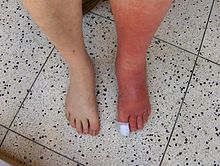
Staph infections are a type of bacterial infection that can occur on the skin or in deeper tissues of the foot. Staphylococcus aureus is the most common type of bacteria that causes staph infections, and it is commonly found on the skin and in the nose of healthy individuals.
Staph infections can occur in different parts of the foot, including the toes, soles, and heels. Symptoms of a staph infection in the foot may include redness, swelling, warmth, and tenderness in the affected area. In some cases, blisters or pus-filled bumps may also be present.
Staph infections of the foot can occur as a result of a break in the skin, such as a cut, scrape, or blister, which allows bacteria to enter the body. They can also occur as a result of a weakened immune system or poor circulation.
Treatment for staph infections of the foot may involve antibiotics, either taken orally or applied topically. In some cases, the infected area may need to be drained to remove pus or other fluids. It is important to seek medical attention if you suspect you have a staph infection, as untreated infections can lead to more serious complications, such as cellulitis, osteomyelitis (infection of the bone), or sepsis.
Prevention of staph infections in the foot includes keeping the feet clean and dry, avoiding sharing personal items, such as shoes or socks, and wearing clean, properly fitting shoes and socks. If you have a cut or scrape on your foot, it is important to clean it thoroughly with soap and water, and cover it with a sterile bandage to prevent infection.
